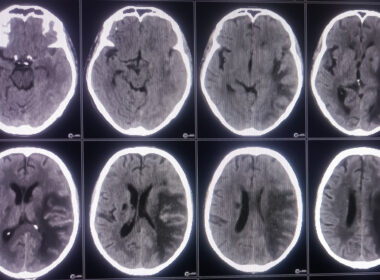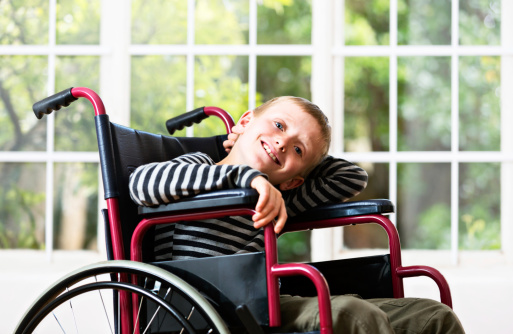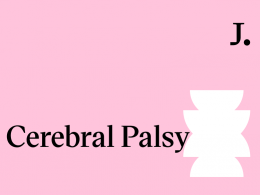Cerebral palsy is a group of disorders that affect a person’s ability to move or maintain bodily balance or posture. This disorder is typically caused by brain damage during birth or abnormal brain development. There are several types of cerebral palsy with different symptoms that are determined by the area of the brain that was damaged during birth.
Symptoms of cerebral palsy vary. Depending on whether the condition is severe or mild, a person might need special equipment to help them walk. In some cases, the person may walk with a limp, but no special equipment is needed. In other circumstances, when the person is not able to walk, they may need lifelong care. Symptoms of cerebral palsy do not progress over time, but the symptoms themselves can change.
What Are Different Types of Cerebral Palsy?
Since cerebral palsy is a condition that is caused by damage to the brain during childbirth, the location of the brain that was affected is vital in knowing the type of cerebral palsy the person has. Determining the type of cerebral palsy is also classified by the symptoms, the parts of the body affected, and the types of movement affected. There are five different types of cerebral palsy: spastic cerebral palsy, ataxic cerebral palsy, athetoid/dyskinetic cerebral palsy, hypotonic cerebral palsy, and mixed cerebral palsy.
Spastic Cerebral Palsy
Spastic cerebral palsy is the most common type of cerebral palsy, affecting nearly 80% of people with cerebral palsy, according to the CDC.
People with this kind of cerebral palsy experience hypertonia, or increased muscle tone. This causes their muscles to be stiff, making it difficult to move normally and often causing spastic and recurring movement of the limbs. This is caused by damage to the motor cortex and the pyramidal tracts of the brain, which control and send messages concerning voluntary movement information from the brain to the muscles.
Based on the type of movement disorder the individual has, spastic cerebral palsy can be further categorized into:
- Spastic Quadriplegia: This is the most severe form of this condition as it affects all four limbs and the entire body. Known for causing hypertonia which restricts movement, it is easily detectable early in life as children do not develop as expected and miss typical developmental milestones. Individuals with this type of spastic cerebral palsy will commonly not be able to walk.
- Spastic Hemiplegia: This form of spastic cerebral palsy occurs when symptoms impact only the left or right side of the body. This is determined by what side of the brain was injured; if the right side of the brain was injured, the left side of the body would be affected.
- Spastic Diplegia: This form of spastic cerebral palsy only affects the lower half of the body. Children with this type of cerebral palsy find it difficult to learn how to walk and experience hip issues as tight hip and leg muscles cause their legs to move inward and cross at the knees.
Ataxic Cerebral Palsy
People with ataxic cerebral palsy typically have issues with balance and coordination. This is one of the more rare types of cerebral palsy as it only affects roughly 5 to 10% of people with cerebral palsy.
Ataxic cerebral palsy affects the cerebellum of the brain, which aids in movement control. As a result, symptoms include difficulty walking, balance issues, poor coordination, and trouble with vision.
Individuals with this type of cerebral palsy may be unsteady when they walk, resulting in them walking with their feet far apart. They might also have a hard time controlling quick movements, or even maneuvering movements that require a lot of control. Basic motor skills such as reaching and grabbing an object may be difficult as this condition can make it hard to properly control hand and arm movement.
Children with ataxic cerebral palsy may also suffer from intention tremors, which can happen when the child’s body trembles when performing an activity or reaching for something.
Athetoid/Dyskinetic Cerebral Palsy
Athetoid/dyskinetic cerebral palsy can cause difficulty controlling movement of the hands, arms, legs, and feet, making it a challenge to not only walk but sit as well. Athetoid/dyskinetic cerebral palsy affects roughly 12 to 14% of people with cerebral palsy and is caused by damage to the basal ganglia of the brain, which is responsible for controlling movements. As a result, individuals can suffer from poor movement control.
Symptoms of this kind of cerebral palsy involve involuntary movement, including slow and squirming or fast and jolty movements in all four limbs. At times, the face and tongue may also be affected, giving the individual a hard time with speaking or swallowing. Lastly, the muscle tone may also be affected, giving the individual muscles that may either be too tight (hypertonia) or too loose (hypotonia). A child’s muscle tone can fluctuate between these extremes.
Athetoid cerebral palsy can also be further categorized depending on what area of the basal ganglia was affected. These include:
- Ataxia, which includes a lack of balance and coordination.
- Athetosis, which may cause squeamish, slow movements of the face, hands, and fingers.
- Chorea, which is known for causing involuntary movements.
- Choreoathetoid, a type of athetoid cerebral palsy that is a combination of chorea and athetosis.
- Dystonia, which involves rotational movements of the limbs.
- Rigidity, which may cause restricted, stiff movements due to high muscle tone.
Hypotonic Cerebral Palsy
Hypotonic cerebral palsy accounts for less than 5% of all cerebral palsy cases, making it one of the rarest types of cerebral palsy. Hypotonic cerebral palsy affects muscle tone to a greater extent. This type of cerebral palsy is also caused by damage to the area of the brain that is responsible for receiving messages from the spinal cord and other areas to control movement.
The muscles affected by hypotonic cerebral palsy tend to be more loose and relaxed than normal, often with limited control by the individual. Other symptoms also include lack of head control, lack of balance, difficulty eating and swallowing, and excessively flexible muscles.
Mixed Cerebral Palsy
As implied in its title, mixed cerebral palsy occurs when the individual experiences multiple symptoms from different types of cerebral palsy. Mixed cerebral palsy is one of the most common types of the condition, with the most common combination being spastic and athetoid cerebral palsies and the least common being a combination of ataxic and athetoid cerebral palsies.
Since mixed cerebral palsy varies by which type of cerebral palsy is present, symptoms can vary for each person. This type of cerebral palsy combines two or more movement difficulties which include the following:
- Hyperkinetic: Unrestrained voluntary or involuntary movements
- Hypokinetic: Slow purposeful movements
- Dyskinetic: Difficulty controlling movements
- Dystonia: Involuntary movement and persistent atypical posture
- Spastic: Elevated muscle tension, rigidness, and awkward or abrupt movements
- Non-spastic: Involuntary movements, and decreased or changing muscle tone
Common symptoms include stiff muscles that make movement difficult or impossible and difficulty with key motor skills, including swallowing and speaking.
Cerebral Palsy Treatment
Cerebral palsy and its symptoms can vary regarding what kind of cerebral palsy the person has. Depending on what area of the brain was injured and to what extent, there are treatments to help all types of cerebral palsy. These treatments may make it easier for individuals to manage their symptoms, feel more in control, and live comfortably.
There are advancements being made every day to better treat cerebral palsy. Deep Brain Stimulation (DBS) is an emerging treatment that involves using electrodes implanted on specific areas of the brain to send electrical pulses to help regulate movement. It has been shown to help reduce uncontrollable tremors and conditions like epilepsy. Brain implants, such as Neuralink, are also helping to transform the way that people with cerebral palsy move and express themselves. Using an implant on the brain, the device records and transmits signals from the brain to Bluetooth-enabled electronic devices.
Currently, cerebral palsy treatment can include one or more of the following:
- Adaptive equipment
- Assistive devices
- Mobility aids
- Medication
- Physical and occupational therapy
- Speech therapy
- Surgery
- Communicative aids
In order to know what treatment will have the best effect, it is important to receive a proper and accurate cerebral palsy diagnosis. Knowing the exact type of cerebral palsy present may give your child and their doctors a greater chance to create a formidable treatment plan for their specific needs.
Resources and Parent Support Groups for Cerebral Palsy
There are numerous nonprofits and community groups available to families who are navigating a new cerebral palsy diagnosis. Connecting with others who have walked a similar path can help you gain tips and knowledge for creating the best life for your child, as well as provide you with important friendships and connections so that you feel less alone. These groups offer important sources of community, support, and guidance.
Nonprofits and parent support groups for cerebral palsy that families should check out include:
- Cerebral Palsy Foundation: A nonprofit that raises awareness for cerebral palsy research and clinical trials
- United Cerebral Palsy: Offers important resources on everything from health insurance to transportation to help families understand and navigate a cerebral palsy diagnosis. UCP also offers support groups throughout the country
- Cerebral Palsy Forum: An online forum to share questions, tips, and resources with other families
- March of Dimes: Raises awareness for health conditions affecting mothers and babies, including conditions like cerebral palsy
Assistance for Cerebral Palsy Treatment
Any kind of medical treatment can be a strain on our finances, but when it comes to health, your own and your child’s, it is important that they receive the utmost care for their condition. Sometimes cerebral palsy is caused by birth injury malpractice. If you suspect that you or your child’s cerebral palsy may have been caused by medical malpractice, you may be able to pursue financial assistance to ease the burden of your medical costs.
Medical professionals have the responsibility to ensure that babies being delivered are handled with expertise and care in order to avoid any unnecessary injuries at birth. If your child has cerebral palsy, there may be a chance that medical negligence contributed to their diagnosis. A lawyer can investigate the circumstances of your case, including conducting a thorough review of the birth mother and child’s medical records, in order to help determine if a medical professional may have made an error or acted carelessly in any way. If they determine that medical negligence occurred, you may be able to pursue justice and compensation by filing a cerebral palsy lawsuit.
Contact us for a free legal consultation to learn more about your rights to possible compensation.












